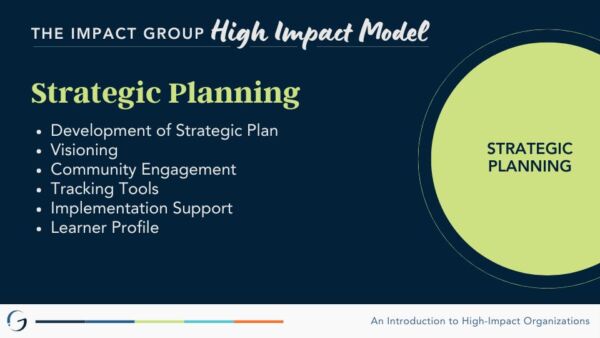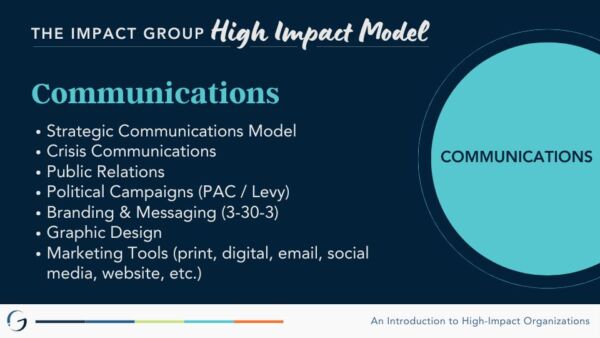What makes an organization successful? 3 Components for Making High-Impact
Public sector organizations, such as school districts and government agencies, encounter distinct challenges while serving diverse communities. Amid limited resources, meeting stakeholder expectations, and driving impactful initiatives, it’s essential for them to uphold their core values. To navigate these complexities, a versatile and cohesive framework like The Impact Group’s High-Impact Model can be employed, helping organizations yield transformational results and maintain efficiency in their operations.
Centered on three interconnected components: strategic planning, communication, and culture development, these three core areas offer a clear path toward creating organizations that succeed even in times of change.
This blog explores how leaders can implement the components of the High-Impact Model to drive meaningful progress, build trust, and empower teams.
The High-Impact Model Framework
Each pillar of the model plays a distinct but interdependent role in shaping success.
1. Strategic Planning
 At its core, strategic planning establishes clarity, focus, and direction. It creates a roadmap for defining goals, allocating resources, and collaborating to deliver measurable results. For public sector organizations frequently navigating political, financial, and operational hurdles, strategic planning ensures initiatives align with the broader mission.
At its core, strategic planning establishes clarity, focus, and direction. It creates a roadmap for defining goals, allocating resources, and collaborating to deliver measurable results. For public sector organizations frequently navigating political, financial, and operational hurdles, strategic planning ensures initiatives align with the broader mission.
Why It Matters
In 2020, Bridges Bussiness Consultancy conducted a survey showing that 48% of leaders spend less than one day a month focused on strategy.
For public sector leaders—like municipal administrators, school superintendents, and nonprofit directors—this lack of focus often leads to challenges such as unclear priorities, resistance to change, and misaligned stakeholders.
Strategic planning addresses these challenges by making decisions focused and practical. When done right, strategic planning helps:
- Align Vision: Match goals with community needs and aspirations.
- Set Priorities: Define specific, actionable objectives to prevent wasted resources.
- Drive Accountability: Create systems to measure and adapt progress.
Implementation Tips for Leaders
Building a strong strategy depends on collaboration, transparency, and trust. Here’s how leaders can set the stage for successful strategic planning:
- Engage Early: Include employees and community voices to build buy-in and uncover insights.
- Use the Data: Gather reliable data to evaluate current performance, identify challenges, and uncover opportunities.
- Create Milestones: Break big-picture goals into smaller, trackable steps. Celebrate early wins to maintain momentum and engagement.
By prioritizing strategic planning and embedding it within the very fabric of your organization, you’re setting the stage for success—not just for today, but for the long term. A well-developed strategic plan not only drives efficiency and effectiveness but also empowers teams to stay aligned and focused.
As we move forward to explore the remaining pillars of the High-Impact Model, keep in mind that strategic planning provides the foundation upon which communication and culture development will build. These pillars, working together, will help your organization navigate complexities and achieve transformational results.
2. Communications
 Communication transforms ideas into action. Even the strongest organizations can falter without clear, consistent, and authentic communication. Whether rallying support, navigating a crisis, or keeping teams engaged, effective communication is non-negotiable.
Communication transforms ideas into action. Even the strongest organizations can falter without clear, consistent, and authentic communication. Whether rallying support, navigating a crisis, or keeping teams engaged, effective communication is non-negotiable.
Why Strategic Communication Works
Effective communication goes beyond simply sharing information. It builds trust, drives alignment, and fosters support for organizational objectives. When communication is clear, it:
- Clarifies Direction: Consistent messaging ensures all stakeholders understand priorities and goals.
- Strengthens Resilience: Transparency builds confidence, particularly during times of change or uncertainty.
- Mobilizes Support: Compelling messaging fosters collaboration and inspires stakeholders to support initiatives actively.
Practical Strategies for Impactful Communication
To develop and maintain trust with both internal and external audiences, leaders can consider these key practices:
- Maintain Transparency: Openly share progress updates, challenges, and decisions to build confidence and credibility. Tailor your message to your audience’s specific concerns.
- A great example of this is our work with Miamisburg City Schools. Their goal to proactively communicate financial information has helped build trust internally and externally, while creating a collective understanding of the complexities of school finance.
- Use Multiple Channels: Leverage diverse communication platforms, including emails, town hall meetings, newsletters, and social media, to reach audiences where they are.
- Tell Stories That Resonate: Use storytelling to make complex concepts relatable and highlight successes. For example, a Board of Development Disabilities may illustrate how a new initiative impacts residents’ day-to-day lives, creating an emotional connection to the mission.
By weaving communication into every layer of strategic execution, public sector leaders can increase engagement, reduce resistance, and create lasting connections across key audiences.
3. Culture Development
 Culture is your organization’s backbone. It shapes how teams work, collaborate, and carry out your overarching mission. For public sector leaders committed to building sustainable success, fostering a values-driven and positive organizational culture cannot be overlooked.
Culture is your organization’s backbone. It shapes how teams work, collaborate, and carry out your overarching mission. For public sector leaders committed to building sustainable success, fostering a values-driven and positive organizational culture cannot be overlooked.
A strong culture promotes cohesion, trust, and a sense of purpose. Conversely, unresolved cultural challenges, like disengagement or misalignment, can impede progress and damage morale.
The Importance of Culture Development
Public sector teams are often tasked with achieving ambitious goals despite limited resources, fluctuating political climates, and growing workloads. A supportive culture empowers teams to rise to these challenges by cultivating trust, innovation, and resilience.
Culture development fosters the following benefits:
- Enhanced Collaboration: Breaks down silos and promotes teamwork across departments or sectors.
- Motivated Teams: Boosts morale and engagement among staff, who feel connected to the mission.
- Effective Leadership: Encourages leaders to act with integrity and inspire confidence.
Building and Sustaining a Strong Culture
A tailored and intentional approach is key for leaders looking to shape a healthier organizational culture. Leaders must:
- Model the Way: Leaders should embody the values they wish to see throughout their organization. Authenticity, consistency, and respect set the tone for everyone.
- Tackle the Hard Stuff: Understand employees’ challenges and address their concerns. This will build trust among your team.
- Tie Roles to Purpose: Help teams see how their work fits into the bigger picture. This will lead to more purpose-driven work and passion for your collective mission.
- Celebrate Achievements: Regularly acknowledge big and small successes to build morale and sustain momentum. As Dr. Melissa Trussell, Associate Professor of Economics at the College of Coastal Georgia, mentions in her Op-Ed on Appreciology, 60% of employees are more motivated by recognition than money.
Investing in culture development can yield powerful returns, including improved satisfaction, retention, and overall performance.
Driving Results with a Cohesive Approach
The true power of The High-Impact Model is in integrating its three core components: strategic planning, communication, and culture development. When aligned, they create a foundation for growth, resilience, and measurable impact.
Aligning strategic priorities with strong internal communication ensures that every team member understands their role and remains motivated toward shared goals. At the same time, fostering a supportive culture makes it easier to implement change initiatives and rally leaders as champions of progress.
While the strength of the High-Impact Model comes from integrating its components, there are times when one area may need to take precedence over the others. For instance, an organization undergoing a significant restructuring might prioritize culture development to maintain morale and cohesion. Conversely, an organization facing external scrutiny may focus on strategic communication to rebuild trust and credibility. This adaptability ensures the model remains relevant and effective, no matter the challenge.
Key Takeaways for Leaders
- Start With Strategy: Create a focused roadmap that aligns with stakeholder needs and defines measurable outcomes.
- Communicate Consistently: Engage audiences with clear, transparent, and tailored messaging to build trust and collaboration.
- Foster Collaborative Cultures: Build internal cohesion through values-driven leadership and proactively addressing employee needs.
- Think Holistically: Ensure strategy, communication, and culture work together to strengthen your organization’s overall impact.




